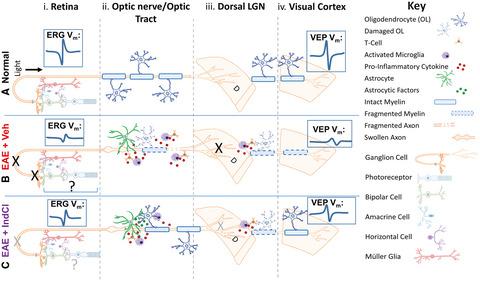当前位置:
X-MOL 学术
›
Brain Pathol.
›
论文详情
Our official English website, www.x-mol.net, welcomes your feedback! (Note: you will need to create a separate account there.)
Alleviation of extensive visual pathway dysfunction by a remyelinating drug in a chronic mouse model of multiple sclerosis
Brain Pathology ( IF 6.4 ) Pub Date : 2020-12-23 , DOI: 10.1111/bpa.12930 Maria T Sekyi 1, 2 , Kelli Lauderdale 1 , Kelley C Atkinson 1 , Batis Golestany 1 , Hawra Karim 1 , Micah Feri 1 , Joselyn S Soto 1 , Cobi Diaz 1 , Sung Hoon Kim 3 , Marianne Cilluffo 4 , Steven Nusinowitz 5 , John A Katzenellenbogen 3 , Seema K Tiwari-Woodruff 1
Brain Pathology ( IF 6.4 ) Pub Date : 2020-12-23 , DOI: 10.1111/bpa.12930 Maria T Sekyi 1, 2 , Kelli Lauderdale 1 , Kelley C Atkinson 1 , Batis Golestany 1 , Hawra Karim 1 , Micah Feri 1 , Joselyn S Soto 1 , Cobi Diaz 1 , Sung Hoon Kim 3 , Marianne Cilluffo 4 , Steven Nusinowitz 5 , John A Katzenellenbogen 3 , Seema K Tiwari-Woodruff 1
Affiliation

|
Visual deficits are among the most prevalent symptoms in patients with multiple sclerosis (MS). To understand deficits in the visual pathway during MS and potential treatment effects, we used experimental autoimmune encephalomyelitis (EAE), the most commonly used animal model of MS. The afferent visual pathway was assessed in vivo using optical coherence tomography (OCT), electroretinography (ERG), and visually evoked cortical potentials (VEPs). Inflammation, demyelination, and neurodegeneration were examined by immunohistochemistry ex vivo. In addition, an immunomodulatory, remyelinating agent, the estrogen receptor β ligand chloroindazole (IndCl), was tested for its therapeutic potential in the visual pathway. EAE produced functional deficits in visual system electrophysiology, including suppression of ERG and VEP waveform amplitudes and increased signal latencies. Therapeutic IndCl rescued overall visual system latency by VEP but had little impact on amplitude or ERG findings relative to vehicle. Faster VEP conduction in IndCl‐treated mice was associated with enhanced myelin basic protein signal in all visual system structures examined. IndCl preserved retinal ganglion cells (RGCs) and oligodendrocyte density in the prechiasmatic white matter, but similar retinal nerve fiber layer thinning by OCT was noted in vehicle and IndCl‐treated mice. Although IndCl differentially attenuated leukocyte and astrocyte staining signal throughout the structures analyzed, axolemmal varicosities were observed in all visual fiber tracts of mice with EAE irrespective of treatment, suggesting impaired axonal energy homeostasis. These data support incomplete functional recovery of VEP amplitude with IndCl, as fiber tracts displayed persistent axon pathology despite remyelination‐induced decreases in latencies, evidenced by reduced optic nerve g‐ratio in IndCl‐treated mice. Although additional studies are required, these findings demonstrate the dynamics of visual pathway dysfunction and disability during EAE, along with the importance of early treatment to mitigate EAE‐induced axon damage.
中文翻译:

通过髓鞘再生药物缓解多发性硬化症慢性小鼠模型中广泛的视觉通路功能障碍
视觉缺陷是多发性硬化症 (MS) 患者最普遍的症状之一。为了了解 MS 期间视觉通路的缺陷和潜在的治疗效果,我们使用了实验性自身免疫性脑脊髓炎 (EAE),这是最常用的 MS 动物模型。使用光学相干断层扫描 (OCT)、视网膜电图 (ERG) 和视觉诱发皮层电位 (VEP) 在体内评估传入视觉通路。通过离体免疫组织化学检查炎症、脱髓鞘和神经变性。此外,还测试了免疫调节、髓鞘再生剂雌激素受体 β 配体氯吲唑 (IndCl) 在视觉通路中的治疗潜力。EAE 在视觉系统电生理学中产生功能缺陷,包括抑制 ERG 和 VEP 波形幅度和增加的信号延迟。治疗性 IndCl 通过 VEP 挽救了整体视觉系统延迟,但对振幅或相对于车辆的 ERG 结果几乎没有影响。IndCl 治疗的小鼠中更快的 VEP 传导与所有检查的视觉系统结构中髓鞘碱性蛋白信号的增强有关。IndCl 保留了视交叉前白质中的视网膜神经节细胞 (RGC) 和少突胶质细胞密度,但在媒介物和 IndCl 处理的小鼠中观察到类似的 OCT 视网膜神经纤维层变薄。尽管 IndCl 在整个分析的结构中不同程度地减弱了白细胞和星形胶质细胞的染色信号,但在 EAE 小鼠的所有视觉纤维束中都观察到了轴突静脉曲张,而与治疗无关,这表明轴突能量稳态受损。这些数据支持使用 IndCl 时 VEP 幅度的功能恢复不完全,因为尽管髓鞘再生诱导的潜伏期减少,但纤维束仍显示出持续的轴突病理,这可以通过 IndCl 治疗小鼠的视神经 g-ratio 降低来证明。尽管需要额外的研究,但这些发现证明了 EAE 期间视觉通路功能障碍和残疾的动态,以及早期治疗对减轻 EAE 诱导的轴突损伤的重要性。
更新日期:2020-12-23
中文翻译:

通过髓鞘再生药物缓解多发性硬化症慢性小鼠模型中广泛的视觉通路功能障碍
视觉缺陷是多发性硬化症 (MS) 患者最普遍的症状之一。为了了解 MS 期间视觉通路的缺陷和潜在的治疗效果,我们使用了实验性自身免疫性脑脊髓炎 (EAE),这是最常用的 MS 动物模型。使用光学相干断层扫描 (OCT)、视网膜电图 (ERG) 和视觉诱发皮层电位 (VEP) 在体内评估传入视觉通路。通过离体免疫组织化学检查炎症、脱髓鞘和神经变性。此外,还测试了免疫调节、髓鞘再生剂雌激素受体 β 配体氯吲唑 (IndCl) 在视觉通路中的治疗潜力。EAE 在视觉系统电生理学中产生功能缺陷,包括抑制 ERG 和 VEP 波形幅度和增加的信号延迟。治疗性 IndCl 通过 VEP 挽救了整体视觉系统延迟,但对振幅或相对于车辆的 ERG 结果几乎没有影响。IndCl 治疗的小鼠中更快的 VEP 传导与所有检查的视觉系统结构中髓鞘碱性蛋白信号的增强有关。IndCl 保留了视交叉前白质中的视网膜神经节细胞 (RGC) 和少突胶质细胞密度,但在媒介物和 IndCl 处理的小鼠中观察到类似的 OCT 视网膜神经纤维层变薄。尽管 IndCl 在整个分析的结构中不同程度地减弱了白细胞和星形胶质细胞的染色信号,但在 EAE 小鼠的所有视觉纤维束中都观察到了轴突静脉曲张,而与治疗无关,这表明轴突能量稳态受损。这些数据支持使用 IndCl 时 VEP 幅度的功能恢复不完全,因为尽管髓鞘再生诱导的潜伏期减少,但纤维束仍显示出持续的轴突病理,这可以通过 IndCl 治疗小鼠的视神经 g-ratio 降低来证明。尽管需要额外的研究,但这些发现证明了 EAE 期间视觉通路功能障碍和残疾的动态,以及早期治疗对减轻 EAE 诱导的轴突损伤的重要性。


























 京公网安备 11010802027423号
京公网安备 11010802027423号